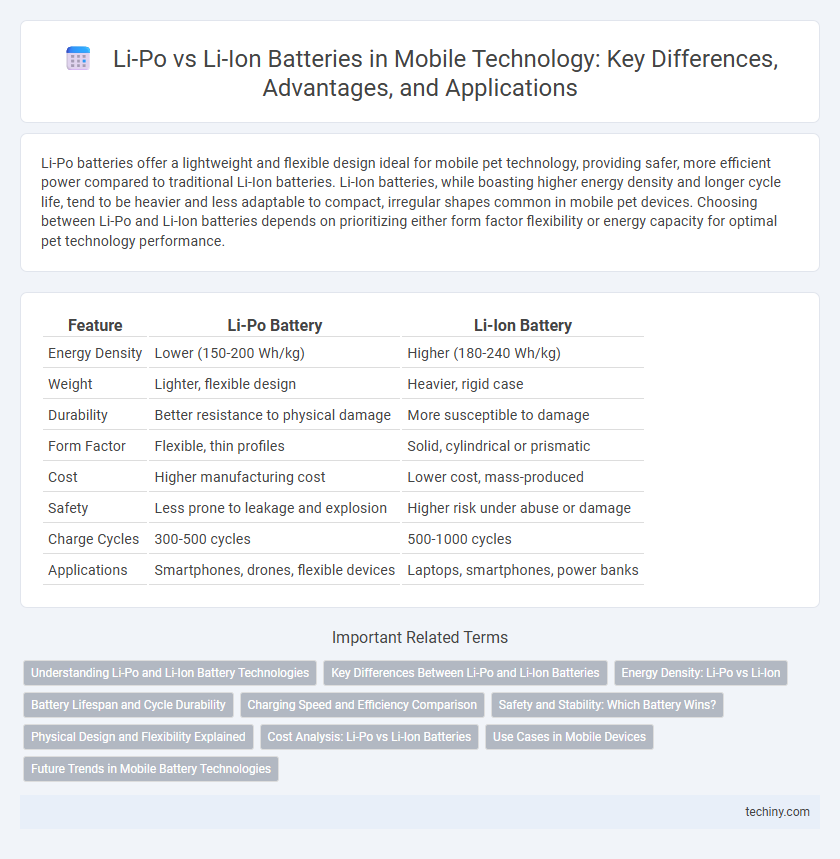Li-Po batteries offer a lightweight and flexible design ideal for mobile pet technology, providing safer, more efficient power compared to traditional Li-Ion batteries. Li-Ion batteries, while boasting higher energy density and longer cycle life, tend to be heavier and less adaptable to compact, irregular shapes common in mobile pet devices. Choosing between Li-Po and Li-Ion batteries depends on prioritizing either form factor flexibility or energy capacity for optimal pet technology performance.
Table of Comparison
| Feature | Li-Po Battery | Li-Ion Battery |
|---|---|---|
| Energy Density | Lower (150-200 Wh/kg) | Higher (180-240 Wh/kg) |
| Weight | Lighter, flexible design | Heavier, rigid case |
| Durability | Better resistance to physical damage | More susceptible to damage |
| Form Factor | Flexible, thin profiles | Solid, cylindrical or prismatic |
| Cost | Higher manufacturing cost | Lower cost, mass-produced |
| Safety | Less prone to leakage and explosion | Higher risk under abuse or damage |
| Charge Cycles | 300-500 cycles | 500-1000 cycles |
| Applications | Smartphones, drones, flexible devices | Laptops, smartphones, power banks |
Understanding Li-Po and Li-Ion Battery Technologies
Li-Po (Lithium Polymer) batteries utilize a gel-like electrolyte allowing flexible, lightweight designs ideal for slim mobile devices, whereas Li-Ion (Lithium Ion) batteries use a liquid electrolyte offering higher energy density and longer cycle life. Li-Po batteries provide enhanced safety with reduced risk of leakage, making them suitable for wearable technology, while Li-Ion batteries dominate smartphones and laptops due to their efficient charge retention and cost-effectiveness. Understanding electrochemical differences and structural benefits helps optimize device performance and battery longevity in mobile technology applications.
Key Differences Between Li-Po and Li-Ion Batteries
Li-Po batteries offer flexible shapes and lighter weight compared to the rigid, heavier Li-Ion batteries, making them ideal for thinner mobile devices. Li-Ion batteries generally provide higher energy density and longer lifespan, whereas Li-Po batteries excel in safety with lower risk of leakage or explosion. The charging efficiency of Li-Ion cells tends to be better, while Li-Po cells support faster charging due to their unique electrolyte composition.
Energy Density: Li-Po vs Li-Ion
Li-Po batteries offer higher energy density compared to traditional Li-Ion batteries, making them ideal for lightweight mobile devices requiring longer usage times. The flexible form factor of Li-Po cells allows more efficient space utilization within compact gadgets, enhancing power storage without increasing size. In contrast, Li-Ion batteries have lower energy density but generally provide higher cycle life and stability, balancing performance and longevity.
Battery Lifespan and Cycle Durability
Li-Po batteries generally offer shorter battery lifespan compared to Li-Ion batteries, with an average of 300-500 charge cycles versus 500-1,000 cycles for Li-Ion cells. Li-Ion batteries exhibit higher cycle durability due to their stable chemistry and better resistance to capacity degradation over time. In mobile technology, choosing Li-Ion batteries enhances device longevity and reduces frequent replacements, making them superior for long-term battery performance.
Charging Speed and Efficiency Comparison
Li-Po batteries typically offer faster charging speeds due to their flexible design and lower internal resistance, enabling efficient energy transfer and reduced heat generation. In contrast, Li-Ion batteries provide high energy density but generally charge slower and can experience efficiency losses at higher temperatures. Optimizing mobile device performance involves balancing the rapid charging benefits of Li-Po with the long cycle life and stability of Li-Ion technology.
Safety and Stability: Which Battery Wins?
Li-Po batteries exhibit superior safety and stability due to their flexible polymer electrolyte, reducing the risk of leakage and thermal runaway compared to Li-Ion batteries. Li-Ion batteries, while offering higher energy density, are more prone to overheating and swelling under stress or damage. In mobile technology, Li-Po batteries are preferred for enhanced safety, especially in devices with slim, compact designs where stability is crucial.
Physical Design and Flexibility Explained
Li-Po batteries feature a flexible, pouch-like design that allows for slimmer and lighter mobile devices, enabling innovative form factors and custom shapes. Li-Ion batteries use a rigid cylindrical or prismatic casing, which limits design flexibility but offers robust structural integrity and consistent performance. The physical adaptability of Li-Po batteries makes them ideal for modern ultrathin smartphones, tablets, and wearable technology.
Cost Analysis: Li-Po vs Li-Ion Batteries
Li-Po batteries typically have a higher production cost than Li-Ion batteries due to their flexible packaging and advanced electrolyte design, which increases manufacturing complexity. Li-Ion batteries remain more cost-effective for mass production, benefiting from economies of scale and established supply chains. However, Li-Po batteries offer longer lifespan and lightweight advantages, which can offset their initial cost in premium mobile devices.
Use Cases in Mobile Devices
Li-Po batteries are preferred in slim smartphones and wearables due to their flexible form factor and lightweight design, allowing for innovative device shapes and improved user comfort. Li-Ion batteries dominate in high-capacity smartphones and tablets where energy density and longer cycle life are critical for extended usage and faster charging needs. Mobile gamers and power users benefit from Li-Ion batteries' stability and efficient performance under heavy load compared to Li-Po alternatives.
Future Trends in Mobile Battery Technologies
Li-Po batteries offer higher energy density and flexible form factors, driving innovation in slim and lightweight mobile devices. Emerging solid-state lithium-ion batteries promise enhanced safety and longer lifespan, potentially surpassing traditional Li-Po and Li-Ion technologies. Research in fast-charging capabilities and sustainable materials is critical to meeting the growing demand for more efficient and environmentally friendly mobile energy solutions.
Li-Po Battery vs Li-Ion Battery Infographic

 techiny.com
techiny.com